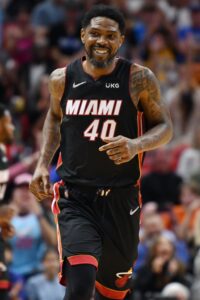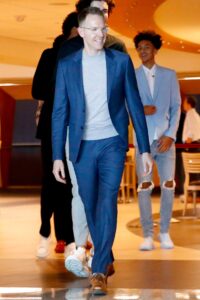Nets head coach Steve Nash participated in the recent meeting between Kevin Durant and team leadership that ended with all parties agreeing to “move forward” with their partnership and focus on basketball. Nash also received a vote of confidence from team owner Joe Tsai earlier this month when word first broke that Durant had asked Tsai to trade him or to fire Nash and general manager Sean Marks.
Still, while Nash’s job may be safe for now, it’s hard to imagine he feels fully secure heading into a season in which the Nets are under pressure to finally deliver on their tantalizing potential and make a deep playoff run. Tsai wasn’t going to give in to Durant’s public request to fire Nash this summer, but it’s not as if Nash’s résumé in his two years coaching the club is spotless — if Brooklyn gets off to a slow start this season, his seat could start to get very hot.
Of the NBA’s 30 head coaches, Nash might be the one whose hold on his job is most tenuous, but there are others who will be worth keeping an eye on over the course of the 2022/23 season.
There was some chatter about Tom Thibodeau‘s job security during a disappointing Knicks season in ’21/22, and while it didn’t amount to anything at the time, that chatter will likely pick up again if New York underachieves for a second straight year after signing Jalen Brunson in free agency.
The Sixers are also under some pressure to take a major step forward this season, and while I’d be a little surprised if Doc Rivers is fired, it’s worth noting that he joined the team before president of basketball operations Daryl Morey did, so he wasn’t a Morey hire. If the 76ers fall short of their expectations and exit the postseason early, I could envision Rivers and the team agreeing to “mutually” part ways.
Chauncey Billups only has one year under his belt as the Trail Blazers‘ head coach, so he shouldn’t be in any immediate danger, but expectations will be significantly higher for Portland this year than they were at the end of last season. The same goes for the Hawks and head coach Nate McMillan, as well as Wizards and head coach Wes Unseld Jr.
Dwane Casey of the Pistons and Stephen Silas of the Rockets have been tasked with overseeing rebuilding projects, so it’s difficult to assess their job performances based on win-loss records. As those teams’ rebuilds begin to move into a new stage, it will be interesting to see if Detroit and Houston remain happy with the jobs that Casey and Silas are doing.
We want to know what you think. Are there any head coaches you believe are already on the hot seat, or ones whose jobs might be in danger if they get off to poor starts this season? Head to the comment section below to weigh in with your thoughts and predictions!

 Sam Presti, Thunder (GM/executive VP): June 7, 2007
Sam Presti, Thunder (GM/executive VP): June 7, 2007